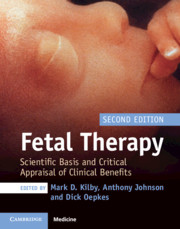Book contents
- Fetal Therapy
- Fetal Therapy
- Copyright page
- Dedication
- Contents
- Contributors
- Foreword
- Section 1: General Principles
- Section 2: Fetal Disease: Pathogenesis and Treatment
- Red Cell Alloimmunization
- Structural Heart Disease in the Fetus
- Fetal Dysrhythmias
- Manipulation of Fetal Amniotic Fluid Volume
- Fetal Infections
- Fetal Growth and Well-being
- Preterm Birth of the Singleton and Multiple Pregnancy
- Chapter 27 The Pathogenesis of Preterm Birth: A Guide to Potential Therapeutic Targets
- Chapter 28 Clinical Interventions for the Prevention and Management of Spontaneous Preterm Birth in the Singleton Fetus
- Chapter 29 Clinical Interventions to Prevent Preterm Birth in Multiple Pregnancies
- Chapter 30 Reducing Neurologic Morbidity from Preterm Birth through Administering Therapy Prior to Delivery
- Complications of Monochorionic Multiple Pregnancy: Twin-to-Twin Transfusion Syndrome
- Complications of Monochorionic Multiple Pregnancy: Fetal Growth Restriction in Monochorionic Twins
- Complications of Monochorionic Multiple Pregnancy: Twin Reversed Arterial Perfusion Sequence
- Complications of Monochorionic Multiple Pregnancy: Multifetal Reduction in Multiple Pregnancy
- Fetal Urinary Tract Obstruction
- Pleural Effusion and Pulmonary Pathology
- Surgical Correction of Neural Tube Anomalies
- Fetal Tumors
- Congenital Diaphragmatic Hernia
- Fetal Stem Cell Transplantation
- Gene Therapy
- Section III: The Future
- Index
- References
Chapter 27 - The Pathogenesis of Preterm Birth: A Guide to Potential Therapeutic Targets
from Preterm Birth of the Singleton and Multiple Pregnancy
Published online by Cambridge University Press: 21 October 2019
- Fetal Therapy
- Fetal Therapy
- Copyright page
- Dedication
- Contents
- Contributors
- Foreword
- Section 1: General Principles
- Section 2: Fetal Disease: Pathogenesis and Treatment
- Red Cell Alloimmunization
- Structural Heart Disease in the Fetus
- Fetal Dysrhythmias
- Manipulation of Fetal Amniotic Fluid Volume
- Fetal Infections
- Fetal Growth and Well-being
- Preterm Birth of the Singleton and Multiple Pregnancy
- Chapter 27 The Pathogenesis of Preterm Birth: A Guide to Potential Therapeutic Targets
- Chapter 28 Clinical Interventions for the Prevention and Management of Spontaneous Preterm Birth in the Singleton Fetus
- Chapter 29 Clinical Interventions to Prevent Preterm Birth in Multiple Pregnancies
- Chapter 30 Reducing Neurologic Morbidity from Preterm Birth through Administering Therapy Prior to Delivery
- Complications of Monochorionic Multiple Pregnancy: Twin-to-Twin Transfusion Syndrome
- Complications of Monochorionic Multiple Pregnancy: Fetal Growth Restriction in Monochorionic Twins
- Complications of Monochorionic Multiple Pregnancy: Twin Reversed Arterial Perfusion Sequence
- Complications of Monochorionic Multiple Pregnancy: Multifetal Reduction in Multiple Pregnancy
- Fetal Urinary Tract Obstruction
- Pleural Effusion and Pulmonary Pathology
- Surgical Correction of Neural Tube Anomalies
- Fetal Tumors
- Congenital Diaphragmatic Hernia
- Fetal Stem Cell Transplantation
- Gene Therapy
- Section III: The Future
- Index
- References
Summary
Preterm birth is defined as delivery of a baby before 37 weeks of pregnancy. In most developed countries the limit of viability (sometimes defined as the gestational age at which the fetus has an equal chance of surviving and not surviving ex utero) is considered to be 24 weeks. A small number of infants born at 23 weeks in high-income nations will survive, whilst mortality in preterm babies born after 32 weeks gestation is similar to that of babies born at term. The risk of neonatal mortality or survival with handicap becomes significant in very preterm infants (born between 28 and 32 weeks) but is most significant in extremely preterm infants (born before 28 weeks). Globally, about 15 million babies are born preterm each year [1]. Over 90% of extremely preterm babies (<28 weeks) born in low-income countries die within the first few days of life, whilst less than 10% of babies born at this gestational age die in high-income settings – a 10:90 survival gap. In most developed nations the rate of preterm birth is below 10%; the UK rate is around 7% and in the USA the rate fluctuates between 9 and 12% with huge geographical variation. Many low-income nations have preterm birth rates exceeding 15%. The proportion of preterm births at each gestational age week increases almost exponentially from about 32 weeks. The majority of preterm births are therefore at later gestational ages. About one-quarter of preterm births are elective deliveries. The remainder are due to preterm labor and delivery [2].
- Type
- Chapter
- Information
- Fetal TherapyScientific Basis and Critical Appraisal of Clinical Benefits, pp. 302 - 310Publisher: Cambridge University PressPrint publication year: 2020

